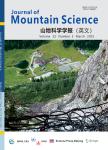Dynamic response of buildings under debris flow impact
作者机构:School of Mechanical and Electrical EngineeringSouthwest Petroleum UniversityChengdu 610500China School of Civil Engineering and GeomaticsSouthwest Petroleum UniversityChengdu 610500China Housing and Urban-Rural Development Bureau of Mingshan DistrictYa’an 625100China Engineering Safety Assessment and Protection ResearchSouthwest Petroleum UniversityChengdu 610500China School of Civil Engineering and ArchitectureSouthwest University of Science and TechnologyMianyang 621010China
出 版 物:《Journal of Mountain Science》 (山地科学学报(英文))
年 卷 期:2024年第21卷第5期
页 面:1581-1597页
核心收录:
学科分类:08[工学] 081402[工学-结构工程] 0837[工学-安全科学与工程] 081304[工学-建筑技术科学] 0813[工学-建筑学] 0814[工学-土木工程]
基 金:supported by the National Natural Science Foundation of China (Grant No. 41877524 No. 42172320 No. 41971214)
主 题:SPH–FEM method Debris flow Buildings The intensity index Dynamic response
摘 要:This study employs the smoothed particle hydrodynamics–finite element method(SPH–FEM) coupling numerical method to investigate the impact of debris flow on reinforced concrete(RC)-frame buildings. The methodology considers the variables of debris flow depth and velocity and introduces the intensity index IDV(IDV = DV) to evaluate three different levels of debris flow impact intensity. The primary focus of this study is to investigate the dynamic response and failure mechanism of RC-frame buildings under debris flow impact, including structural failure patterns, impact force and column displacement. The results show that under a highintensity impact, a gradual collapse process of the RCframe building can be observed, and the damage mode of the frame column reflects shear failure or plastic hinge failure mechanism. First, the longitudinal infill walls are damaged owing to their low out-of-plane flexural capacity;the critical failure intensity index IDV value is approximately 7.5 m2/s. The structure cannot withstand debris flows with an intensity index IDV greater than 16 m2/s, and it is recommended that the peak impact force should not exceed 2100 k N. The impact damage ability of debris flow on buildings mostly originates from the impact force of the frontal debris flow, with the impact force of the debris flow body being approximately 42% lower than that of the debris flow head. Finally, a five-level classification system for evaluating the damage status of buildings is proposed based on the numerical simulation and investigation results of the disaster site.




